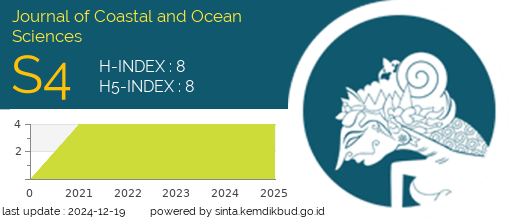Seasonal Current Circulation Patterns in the Waters of the Malacca Strait
DOI:
https://doi.org/10.31258/Keywords:
Tidal, Current circulation, Malacca StraitAbstract
The Malacca Strait is a water that connects the Indian Ocean and the South China Sea (Pacific Ocean). The Straits of Malacca is the busiest waters because it is filled with activities in and out of ships, fishing activities, ecotourism, and community sea transportation. These activities significantly affect the condition of the waters in the Malacca Strait. Water conditions are greatly affected by oceanographic parameters. One of the most critical parameters is currents. This ocean current is a horizontal movement of water masses influenced by other oceanographic factors. This research was conducted in June - July 2022. This study aimed to determine the pattern of current circulation, direction, and speed of currents as well as sea level during conditions at full moon (highest tide) and new low tide (Lowest tide) each month and every season in the Straits of Malacca. The method used in this research is descriptive quantitative, where numerical data is collected to support the formation of numerical models such as wind, tidal, and bathymetry data. Numerical modeling is a function of the software to determine the pattern of current movement based on the data used. Based on the four seasons (West Season, Transition I, East, and Transition II) at high tide. The highest current speed ranges from 0.02 to 2.07 m/s, while at high tide, the highest current speed ranges from 0.03 to 2.58 m/s.
Downloads
References
Amirullah, A.N., Sugianto, D.N., Indrayanti, E. (2014). Kajian Pola Arus Laut dengan Pendekatan Model Hidrodinamika Dua Dimensi untuk Pengembangan Pelabuhan Kota Tegal. Jurnal Oseanografi, 4(3): 671-682.
Anisa, M.N., Purwanto, P., Prasetyawan, I.B. (2017). Studi Pola Arus Laut di Perairan Tapaktuan, Aceh Selatan. Journal of Oceanography, 6(1): 183-192
Anwar, N. (2007). Model Sirkulasi Arus Menggunakan Model Numerik Dua Dimensi Hidrodinamik Pom di Perairan Selat Rupat. Skripsi. Fakultas Perikanan dan Ilmu Kelautan. Universitas Riau.
Aziz, M.F. (2006). Gerak Air di Laut. Oseana, 4(21): 9-21
Denny, N., & Agus. (2012). Pola Sirkulasi Arus Laut di Perairan Pantai Provinsi Sumatera Barat. Ilmu Kelautan: Indonesian Journal of Marine Sciences, 12(2): 79–92.
Fu, L.L. (2014). Ensiklopedia Remote sensing. Ocean Surface Topography, p455-461.
Gaol, J.L., & Sadhotomo, B. (2007). Karakteristik dan Variabilitas Parameter Oseanografi Laut Jawa. Jurnal Lit.Perikanan.Ind, 13(3): 201-211.
Hadi, S., & Radjawane, I. (2009). Arus Laut. Institut Teknologi Bandung. Bandung.
Okol, S.S., & Dian, A. (2018). Studi Hasil Running Model Arus Permukaan dengan Software Numerik Mike 21/3 (Guna Penentuan Lokasi Penempatan Stasiun Energi Arus Selat Lombok-Nusapenida). Applied Technology and Computing Science Journal, 1(1): 30-38
Poerbandono & Djunasjah, E. (2005). Survei Hidrografi. PT. Refika Aditama, Bandung. p166.
Pratama, K.Y., Pasetyawan, I.B., Atmodjo, W. (2014). Studi Pola Arus di Perairan Khusus Pertamina PT. Arun Lhoksumawe, Aceh. Jurnal Oseanografi, 3(2): 220-229.
Supiyati. (2005). Model Hidrodinamika Pasang Surut di Perairan Pulau Baai, Bengkulu. Gradient, 1(2): 51-55






